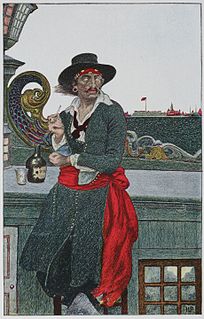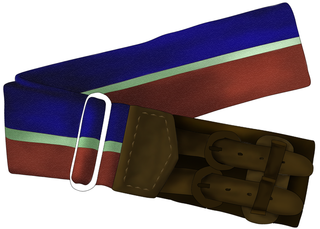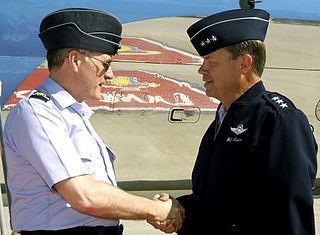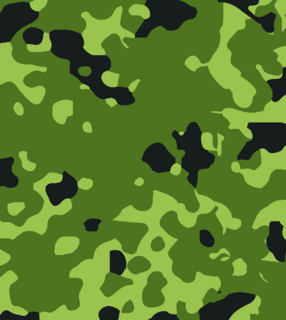
A sash is a large and usually colorful ribbon or band of material worn around the body, either draping from one shoulder to the opposing hip and back up, or else running around the waist. The sash around the waist may be worn in daily attire, but the sash from shoulder to hip is worn on ceremonial occasions only. Ceremonial sashes are also found in a V-shaped format, draping straight from both shoulders down, intersecting and forming an angle over the chest or stomach.

The Royal Danish Army is the land-based branch of the Danish Defence, together with the Danish Home Guard. For the last decade, the Royal Danish Army has undergone a massive transformation of structures, equipment and training methods, abandoning its traditional role of anti-invasion defence, and instead focusing on out of area operations by, among other initiatives, reducing the size of the conscripted and reserve components and increasing the active component, changing from 60% support structure and 40% operational capability, to 60% combat operational capability and 40% support structure. When fully implemented, the Danish army will be capable of deploying 1,500 troops permanently on three different continents continuously, or 5,000 troops for a shorter period of time, in international operations without any need for extraordinary measures such as parliamentary approval of a war funding bill.

A stable belt is a striped coloured belt worn at times by the armed forces of the United Kingdom and other Commonwealth countries – and a few other countries such as Denmark, Brazil and Lebanon. The stripes identify and vary by regiment and corps. In Brazil and Lebanon they are known as gymnastic belts.

A parachutist badge is a military badge awarded by the armed forces of many states to soldiers who have received parachute training and completed the required number of jumps. It is difficult to assess which country was the first to introduce such an award.

Insignias and badges of the United States Navy are military badges issued by the United States Department of the Navy to naval service members who achieve certain qualifications and accomplishments while serving on both active and reserve duty in the United States Navy. Most naval aviation insignia are also permitted for wear on uniforms of the United States Marine Corps.

Insignia and badges of the United States Marine Corps are military "badges" issued by the United States Department of the Navy to Marines who achieve certain qualifications and accomplishments while serving on both active and reserve duty in the United States Marine Corps.

A side cap is a military cap that can be folded flat when not being worn. It is also known as a garrison cap or flight cap in the United States, wedge cap in Canada, or field service cap in the United Kingdom. In form the side cap is comparable to the glengarry, a folding version of the Scottish military bonnet. It has been associated with various military forces since the middle of the 19th century, as well as various civilian organizations.

The Command at Sea insignia is a badge of the United States' seagoing services worn by officers on their uniforms to denote that they are the commander, or formerly a commander, of a warship. If the wearer is currently the commander of a warship, it is worn above the nametag, which is worn a quarter of an inch above the right chest pocket on a uniform shirt. Afterwards, the pin is moved to the left side of the shirt or jacket. For the commanders of land-based installations, a different but similar version known as the Command Ashore insignia instead.

Full dress uniform, also known as a ceremonial dress uniform or parade dress uniform, is the most formal type of uniforms used by military, police, fire and other public uniformed services for official parades, ceremonies, and receptions, including private ones such as marriages and funerals. Full dress uniforms typically include full-size orders and medals insignia. Styles tend to trace back to uniforms used during the 19th century, although the 20th century saw the adoption of mess dress-styled full-dress uniforms. Designs may depend on regiment or service branch. In Western dress codes, full dress uniform is a permitted supplementary alternative equivalent to the civilian white tie for evening wear or morning dress for day wear – sometimes collectively called full dress – although military uniforms are the same for day and evening wear. As such, full dress uniform is the most formal uniform, followed by the mess dress uniform.
The uniforms of the Canadian Armed Forces are the official dress worn by members of Canada's military while on duty.

The uniforms of the British Army currently exist in twelve categories ranging from ceremonial uniforms to combat dress. Uniforms in the British Army are specific to the regiment to which a soldier belongs. Full dress presents the most differentiation between units, and there are fewer regimental distinctions between ceremonial dress, service dress, barrack dress and combat dress, though a level of regimental distinction runs throughout.

The United States Marine Corps (USMC) prescribes several types of military uniform to distinguish its service members from other armed services, depending on the situation.
The uniforms of the United States Army distinguish soldiers from other service members. U.S. Army uniform designs have historically been influenced by British and French military traditions, as well as contemporary U.S. civilian fashion trends. The two primary uniforms of the modern U.S. Army are the Army Combat Uniform, used in operational environments, and the Army Green Service Uniform worn during everyday professional wear and during formal and ceremonial occasions that do not warrant the wear of the more formal blue service uniform.
The Ranks and insignia of Royal Danish Army follows the NATO system of ranks and insignia, as does the rest of the Danish Defence. The ranks are based around German and French military terms.

Troops began wearing berets as a part of the headgear of military uniforms in some European countries during the 19th century; since the mid-20th century, they have become a component of the uniforms of many armed forces throughout the world. Military berets are usually pushed to the right to free the shoulder that bears the rifle on most soldiers, but the armies of some countries, mostly within Europe, South America, and Asia, have influenced the push to the left.

The British Armed Forces award a range of Parachutist Badges to those qualified as military parachutists. The version awarded depends largely on the unit or role that the individual fills following qualification.

The M/84 camouflage pattern, is the former camouflage pattern of the Danish military. The M/84 is a derivative of the Flecktarn B pattern produced by the German firm Marquardt & Schulz. Using the same shapes and pattern, the number of colours was changed from 5 to 3 – choosing olive green, light green and black to better match the colouration of the Danish woodland environment.

The Uniforms of the Royal Danish Army distinguish soldiers from other service members. Royal Danish Army uniforms were originally influenced by French, Prussian and Russian military traditions. However, in more recent times, its uniforms have been characterized as being influenced by British uniforms, and, more significantly, American uniforms.

The Chief of the Army Command is the service chief of the Royal Danish Army. The current chief is Major general Gunner Arpe Nielsen.

The Chief of the Air Command is the topmost authority in the Royal Danish Air Force. It can trace its history back to the creation of the Chief for the Naval Air Service, in 1913. The current chief of the Air Force is Major general Jan Dam.







































